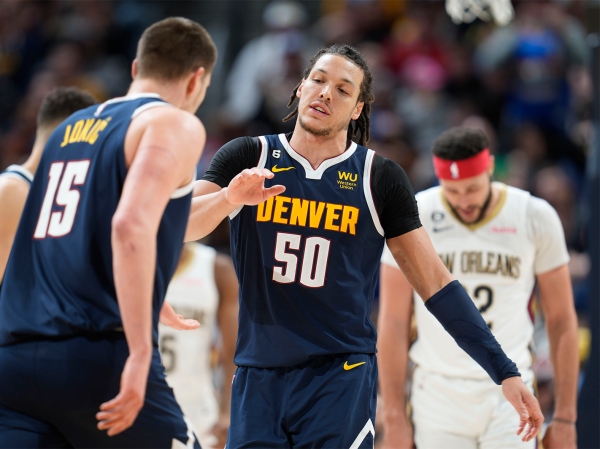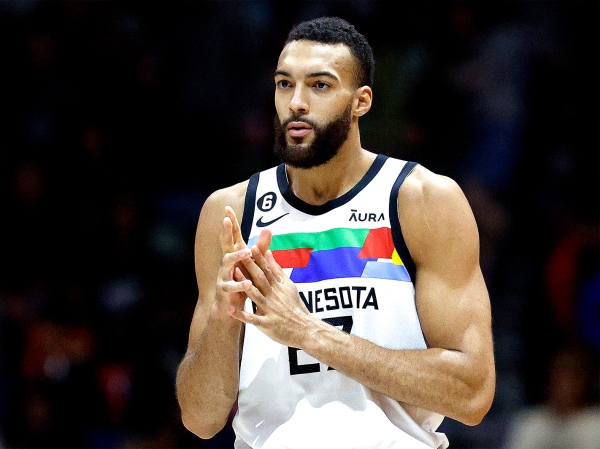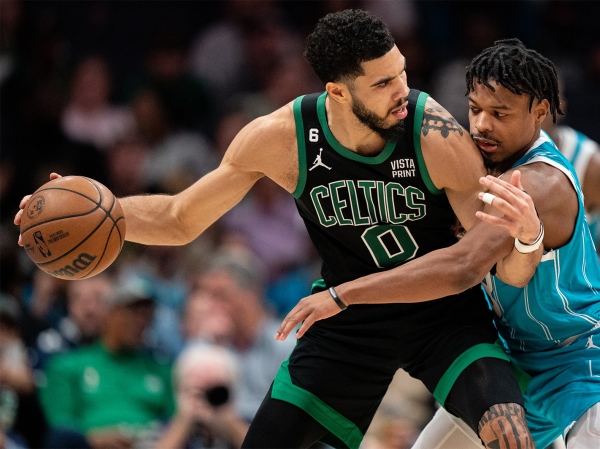The Cavaliers Bet Big On Donovan Mitchell. Here’s Why It’s Working.

JASON MILLER / GETTY IMAGES
Last season, the Cleveland Cavaliers were arguably the NBA’s most improved team. After going just 22-50 during the pandemic-shortened 2020-21 campaign, Cleveland improved its record all the way to 44-38, making the second-largest season-to-season jump in winning percentage behind the Minnesota Timberwolves. And on a per-possession basis, the Cavs lapped the field in improvement with a 10.8-point spike in their net rating — 2.7 points per 100 possessions better than that of any other squad.
A rash of injuries throughout that season (Collin Sexton, Ricky Rubio and Jarrett Allen chief among them) led to Cleveland faltering down the stretch and eventually failing to make it out of the play-in round. But after that small taste of success, the Cavaliers swung the biggest move of the NBA offseason, trading Sexton, rookie Ochai Agbaji, Lauri Markkanen and a bushel of first-round picks to the Utah Jazz in exchange for Donovan Mitchell. Adding Mitchell to a core that already included All-Stars in Allen and Darius Garland, plus the Rookie of the Year runner-up in Evan Mobley, gave Cleveland one of the league’s deepest wells of star talent.1
Although that hasn’t fully manifested itself in FiveThirtyEight’s RAPTOR-based prediction model (we still call for Cleveland to fall just shy of 50 wins), the Cavs currently have the NBA’s fourth-best record (16-9), with the point differential of an 18-7 team, and they’re one of just four teams ranked inside the top 10 on both offense and defense.2 Let’s dig into what’s driving that success, as well as some things that could tip the scales toward the Cavs leveling up even further.
The small backcourt hasn’t hurt on defense
The Cavaliers’ defense is, in fact, the best in basketball right now — a bit of a surprise, considering it was the defensive side of the floor where observers had the biggest question marks about how the trade for Mitchell would work out. Garland had been a negative defender through his first three NBA seasons, and Mitchell had taken dramatic steps backward on that end. Both of those players are listed at a mere 6-foot-1, typically putting Cleveland at a tremendous size disadvantage in the backcourt.
There have been only 11 teams since the 1999-2000 season to give at least 41 starts to a pair of players listed 6-foot-1 or shorter. Interestingly, that list includes both the 2019-20 and 2020-21 Cavaliers with Garland, as well as the 2019-20, 2020-21 and 2022-22 Jazz with Mitchell.
Garland and Mitchell are no strangers to pint-sized backcourts
NBA teams since 1999-2000 who gave at least 41 starts each to two players listed at 6-foot-1 or shorter in the same season
| Year | Team | Players | Defense Rk. | |
|---|---|---|---|---|
| 2022 | Jazz | Mike Conley | Donovan Mitchell | 11 |
| 2021 | Hornets | Devonte’ Graham | Terry Rozier | 17 |
| 2021 | Cavaliers | Darius Garland | Collin Sexton | 25 |
| 2021 | Raptors | Kyle Lowry | Fred VanVleet | 15 |
| 2021 | Jazz | Mike Conley | Donovan Mitchell | 4 |
| 2020 | Hornets | Devonte’ Graham | Terry Rozier | 24 |
| 2020 | Cavaliers | Darius Garland | Collin Sexton | 29 |
| 2020 | Raptors | Kyle Lowry | Fred VanVleet | 2 |
| 2020 | Jazz | Mike Conley | Donovan Mitchell | 13 |
| 2008 | Nuggets | Anthony Carter | Allen Iverson | 10 |
| 2006 | Bobcats | Raymond Felton | Brevin Knight | 18 |
As I wrote when the Mitchell deal went down, teams with these pint-sized backcourts generally ranked around the defensive league average, but that average was skewed by a couple of very high-level performances across the league. (The 2020-21 Jazz had Rudy Gobert, an all-time interior defender, while the 2019-20 Raptors were running an extremely innovative defensive system and were stocked with elite, multi-positional defenders.) Without those two outliers, the typical defense with a tiny backcourt was below average. But what gave the Cavs outlier potential of their own was the massive nature of their frontcourt (and the defensive acumen of their two starting big men), which could offset the size disadvantage of their guards.
And that’s pretty much exactly how things have worked for this version of the Cavs. Mitchell vowed before the season that he would “lock in” more on defense, and he’s kept that promise to date; Garland showed some growth as a defender last season, and it has continued this year, but the defense is still anchored by the bigs.
Allen remains one of the NBA’s premier protectors of the basket: Among 29 players who have played in at least 10 games and challenged at least 5 shots per night, Allen ranks second in opponent field-goal percentage when within 5 feet of both the rim and the shooter, according to NBA.com. Mobley remains one of the league’s best switch-defenders in space: Among 137 players who have switched 35 or more ball screens, according to Second Spectrum, he ranks 11th in points per possession allowed (0.696) when the play is finished by the ball handler or a teammate one pass away.
Garland has pulled his weight on offense
It’s at least interesting that the Cavaliers’ offense is a bit behind their defense, especially considering that following the Mitchell trade it was widely speculated the team’s offense would be fine and the defense might take some time to come around. But scoring at the eighth-best rate in basketball is pretty damn good, to be clear. There are signs that the current state of Cleveland’s offense is propped up by unsustainable shooting, but reassuringly, there’s also some low-hanging fruit the Cavs can pluck to counteract any shooting regression.
For example, it’s highly encouraging that Cleveland’s offense in Garland-only minutes has been nearly as good as in Mitchell-only minutes. The duo shares the ball handling responsibility pretty equally when in the game together, but they each take on a much clearer lead-dog role when the other isn’t on the floor with them. That the Cavs have maintained their scoring efficiency with one or the other on the bench is a good sign.
The Cavs’ guards are playing the right roles — together or apart
In-possession stats for Darius Garland and Donovan Mitchell when on the court together or by themselves, 2022-23 season
| Player/Situation | Poss. | Seconds/ Touch |
Dribbles/ Touch |
Time of Poss. % | Pts/ Poss. |
|---|---|---|---|---|---|
| Garland w/ Mitchell | 2148 | 5.877 | 5.481 | 27.3% | 1.13 |
| Garland w/o Mitchell | 466 | 5.658 | 5.261 | 45.4 | 1.20 |
| Mitchell w/ Garland | 2148 | 5.261 | 4.730 | 26.1 | 1.17 |
| Mitchell w/o Garland | 794 | 5.791 | 5.365 | 43.2 | 1.16 |
Garland’s usage rate has actually gone up just a bit this season despite Mitchell’s presence, and he hasn’t experienced much of a drop-off in his true shooting percentage. Garland remains a long-range sniper, connecting on more than 38 percent of his threes for the third consecutive season. He’s also become an improved passer, as evidenced by both his career-low turnover rate and the fact that he’s on pace for about 47 fewer bad-pass giveaways per 82 games than he had a season ago. If he can get back to hitting his floaters around 50 percent of the time (like he did last season), Garland can be even better.
Mitchell is shooting the lights out
Speaking of shooting … We have to talk about Mitchell, who is posting career-best numbers in basically every shooting category. He’s connected on 55.4 percent of his two-point shots, 42.4 percent of his threes and 49.6 percent of his shots overall. These figures are far and away the best of his career. That’s also the case for his 77 percent conversion rate on shots within 3 feet of the basket and his 53.1 percent mark on shots 3 to 10 feet out.
Is it possible that playing alongside a talent of Garland’s caliber could account for some of this improvement? Of course, it is. However, it’s highly unlikely that Garland’s presence accounts for Mitchell’s otherworldly off-the-dribble shooting.
Through his first five seasons, Mitchell’s career-best effective field goal percentage on jump shots taken after two or more dribbles was 52.99 percent, according to Second Spectrum. This year, that figure has shot all the way up to 62.07 percent, despite the fact that those off-dribble jumpers have: a) been more closely contested than ever and b) yielded the second-worst expected conversion rate of his career.3 Mitchell just happens to be outperforming expectations on those shots by the third-largest margin of any of the 692 players who have taken 150 or more them in a season during the player-tracking era, which now spans 10 seasons.
Mitchell’s pull-up shooting has been 🔥 this season
Best quantified shooter impact (qSI) in a season for NBA players on jumpers after 2 or more dribbles, 2014-23
| Player | Season | Team | Shot Att. | eFG% | qSQ* | qSI† |
|---|---|---|---|---|---|---|
| Kevin Durant | 2023 | BRK | 216 | 58.1% | 38.4% | +19.7 |
| Stephen Curry | 2023 | GSW | 152 | 64.8 | 45.9 | +19.0 |
| Donovan Mitchell | 2023 | CLE | 174 | 62.1 | 43.6 | +18.5 |
| Kevin Durant | 2021 | BRK | 201 | 57.2 | 40.0 | +17.3 |
| Rudy Gay | 2019 | SAS | 179 | 55.3 | 38.1 | +17.2 |
| Stephen Curry | 2021 | GSW | 425 | 60.2 | 44.8 | +15.4 |
| DeMar DeRozan | 2022 | CHI | 788 | 50.8 | 36.1 | +14.7 |
| Kyrie Irving | 2021 | BRK | 422 | 56.6 | 42.2 | +14.4 |
| Stephen Curry | 2016 | GSW | 547 | 59.5 | 45.2 | +14.3 |
| Damian Lillard | 2020 | POR | 558 | 58.1 | 44.8 | +13.2 |
| Kevin Durant | 2022 | BRK | 459 | 51.7 | 38.6 | +13.2 |
| Chris Paul | 2021 | PHO | 608 | 55.4 | 42.3 | +13.1 |
And there’s still room for improvement
Even if Mitchell’s outrageous off-dribble shooting reverts to form, there’s reason to believe that the Cavs can remain a top offense. The foundation of their attack is, like for most teams, the high pick and roll, and the Mitchell-Allen and Garland-Allen duos rank first (Mitchell 1.421) and 29th (Garland, 1.184) in points per possession among the 99 teammate pairings with 100 or more ball screens, per Second Spectrum.4
More than anything else, though, the Cavs can boost their offense by speeding things up a bit. Despite being at a talent advantage almost every night, Cleveland plays at the slowest pace in the league. Overall, no NBA team is slower to get into its offense: According to Second Spectrum, it takes 7.27 seconds for the Cavs to initiate the first action (a cut, screen, drive, etc.) on their average trip up the floor. Cranking up the speed and getting into things a second or so faster could mean the difference between having to put up a contested shot near the end of the clock and being able to pump-fake and get a little bit more open. Cleveland’s expected effective field goal percentage ranks just 16th in the NBA; playing with more pace could nudge that number toward or even into the top 10.
It would also help because the Cavs almost never get out on the break, with just 13.7 percent of their non-garbage-time possessions coming in transition, according to Cleaning the Glass. That’s the league’s fourth-lowest rate. Transition possessions are, predictably, far more efficient than those run against a set defense in the halfcourt, so increasing the rate at which they run can also help get the offense where it needs to be for the Cavs to firmly keep themselves among the league’s elite.
They’ll also want to shore up the team’s wing depth at some point, especially if they can acquire a player to actually help on both sides of the ball. Caris LeVert is shooting just 37 percent from the field. Isaac Okoro undermines the team’s offensive structure whenever he’s on the floor because he is both reluctant to take and unable to reliably make shots, and his defense hasn’t been good enough to make up for it. Cedi Osman, Dean Wade and Lamar Stevens at least have the size to handle big-wing defensive assignments — but of the three, only Wade can consistently shoot, and only Osman can really put the ball on the deck. In a league dominated in large part by big-wing creators, the Cavs have a glaring hole in that department.
Still, the Cavs bet that acquiring Mitchell would vault them into the realm of contention, and so far it appears that bet is working out quite nicely. Even if the Cavs are not necessarily on the level of the Celtics or Bucks, they are much closer than they were a year ago — and they have laid a foundation for sustainable contention over the next few years, with a core group of players that should only get better. The price they paid was high, but so is the potential pay-off.
Check out our latest NBA predictions.



